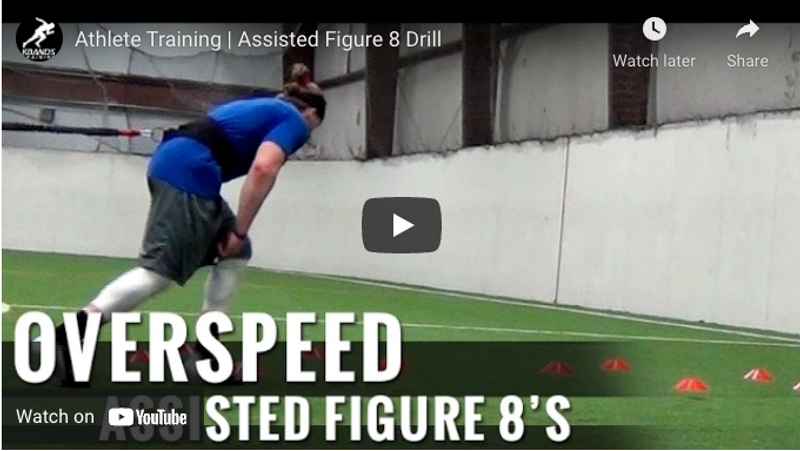Training Drills for Increased Change Of Direction | Figure 8’s
In almost every high-intensity sport, including football, basketball, soccer and lacrosse, athletes sometimes need to maintain full speed while navigating within very small spaces. Running in a full-out straightaway sprint and running in a tight circle place very different demands on an athlete, both mentally and physically. So a complete and comprehensive athletic training program will give sufficient attention to both formats. While in the straightaway, runners concentrate on the dig phase, arm engagement, forward focus, a low chest, and explosive, powerful drive in the knees and hips. In a tight circle, athletes need to concentrate on balance without compromising speed.
In tight formations, the arms support balance and control in the core, and the feet move in short, choppy steps that also require an element of control. At the same time, game situations place pressure on the athlete from all directions in an unpredictable pattern, and any successful athletic training program will help the athlete develop the reflexes to predict and respond to that pressure.
In this athlete training drill, called the Assisted Figure 8 Drill, athletes will apply the skills they gained in other drills, specifically those focused on straightforward sprints and rapid direction changes. But in this case, these skills will be applied all at the same time, since the direction change will be constant, the running pattern will be tight, and the drill will involve the added resistance and assistance of the Kbands Reactive Stretch Cord.
This athlete training drill requires a specific set of equipment that can be set up and taken down in just a few minutes. The Assisted Figure 8 Drill can be executed multiple times or in just a few quick sets, and it can involve individuals or an entire team. Each athlete should execute the drill with the help of an anchoring partner, and each participant will need access to a Reactive Stretch Cord.
Athletic Training: Setting Up the Assisted Figure 8’s Drill
To complete this athlete training drill, teams will need at least one figure-eight pattern made of Speed and Agility training cones. The cones should be placed in two tight circles about three to four feet apart. More figure eights will allow more participants to complete the drill at the same time, and each pattern will require eight to ten cones.
As one participant sets up the cones, the other can attach the Reactive Stretch Cord band around the waist, pulling the strap snug so the band stays in place but the metal ring moves freely around the athlete’s body. When the band is in place, the Reactive Stretch Cord can be clipped to the ring and the other end can be placed in the hand of the anchoring partner. The safety strap should be securely attached around the partner’s wrist, so the cord stays safe and under control.
Athletic Training: Executing the Assisted Figure 8’s Drill
When the Reactive Stretch Cord is in place and the Speed and Agility Cones have been placed in a figure eight pattern, the Assisted Figure 8’s drill can begin. The runner can stand at the far end of the pattern, with the anchoring partner standing about seven feet away from the opposite end. As long as the runner completes and equal number of reps on each side, the starting point can be on either the right or the left side of the pattern. Both participants should keep in mind that the cord should not stretch to a distance greater than 20 feet at any time, and the anchoring partner should be prepared to stay in motion in order to apply a varied pattern of assistance and resistance as the runner completes the athletic training drill.
At the starting signal, the athlete will break into a full speed run that stays tight to the cones. After moving around one of the small circles, the athlete will complete a lap around the other circle and then break into a straightaway sprint out of the pattern and down the field.
While the athlete circles the cones, the anchoring partner will maintain a tight grip on the end of the Reactive Stretch Cord and keep continuous pressure applied to the athlete’s core from every direction. The more varied the pressure, the better this athlete training drill will simulate game-like situations.
Keeping steady pressure will require mobility, so the anchoring partner will begin the drill at dead center, and then will move toward the cone formation and away as the athlete completes the sprint pattern. There should never be slack in the cord, and the position of the anchoring partner should transition the pressure of the cord from resistance to assistance and back again as the athlete turns. Partners should work together to keep the resistance and assistance level at about ten to fifteen percent during the entire exercise. Too much or two little can lead to breaking or over-striding, which can undermine the benefits of the athletic training drill.
The Assisted Figure 8’s Drill: Final Notes
This athlete training drill should involve three resisted reps from both sides of the figure eight pattern. After all six reps, the Reactive Stretch Cord can be unclipped from the metal ring and the athlete can complete two more reps without any resistance in place. During the final unresisted reps, the athlete will feel the neurological sensation of lightness that takes place after both resistance and assistance have been removed. Runners should take advantage of this sensation while it lasts and should stay focused on balance, control, and explosiveness during the turns.

